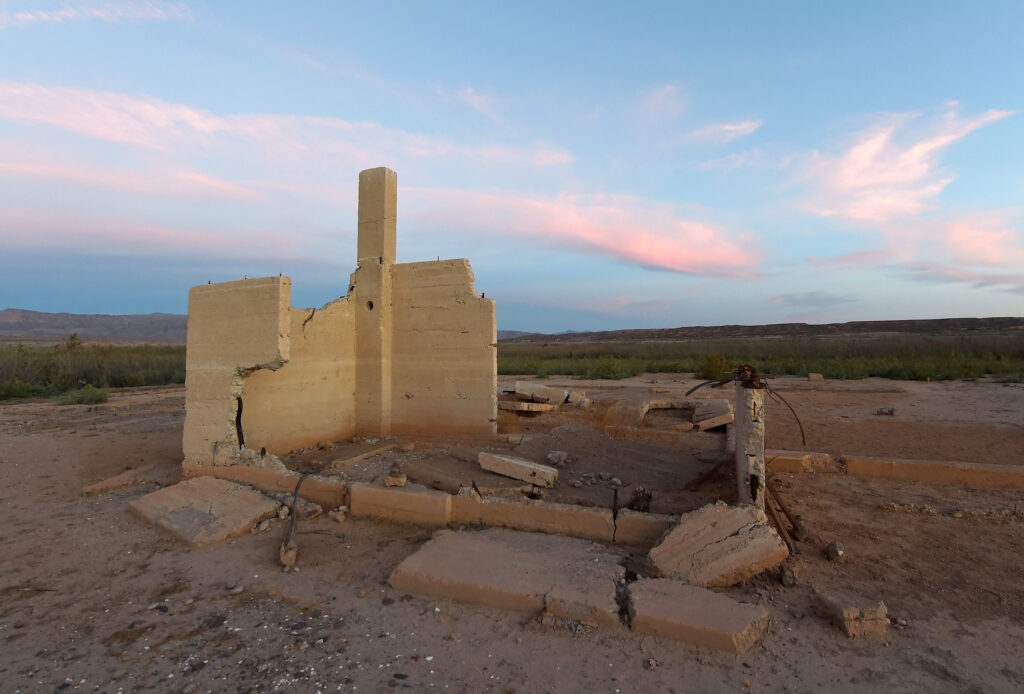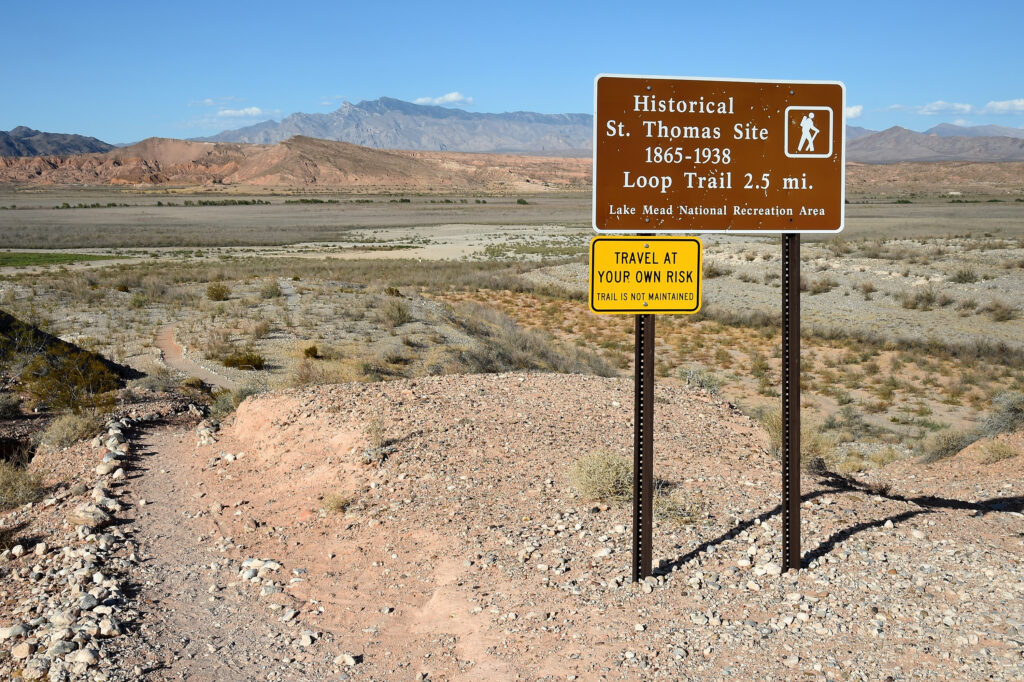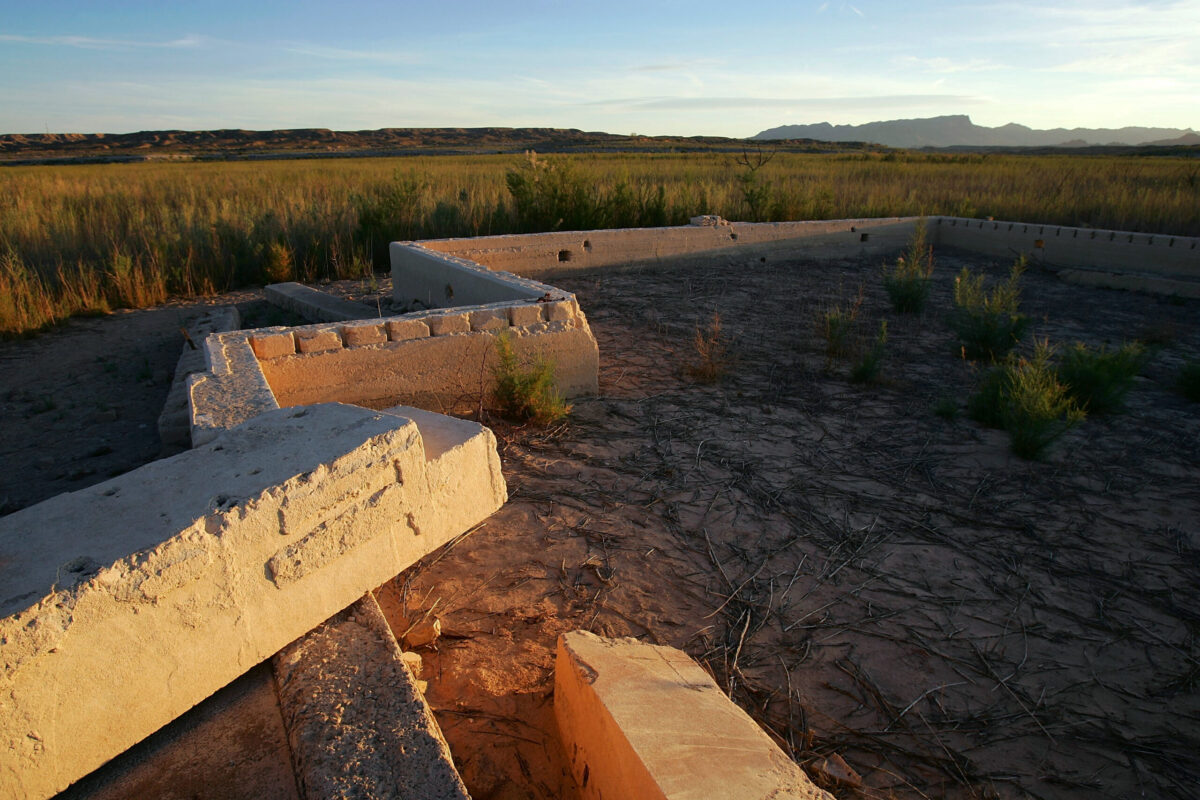Is it hyperbolic to compare the ghost town of St. Thomas, Nev., to a phoenix rising from the ashes? Perhaps. But it’s also not too far off—if you can get past the elemental differences. For unlike the gaudily plumed bird, this once-submerged settlement has risen from water. It has on and off for decades, thanks to the fickle fluctuations of Lake Mead. Noteworthy appearances have included 1945, 1963 and 2012, and relentless aridity in recent years means lucky visitors can scope it out today. Of course, getting there requires a little work.
In the northern reaches of Lake Mead National Recreation Area, St. Thomas lies just west of the Muddy River, which feeds the Overton Arm of the lake. Best reached during the oven-baked summer months, the townsite is readily accessible via a high-clearance four-wheel drive vehicle. A jostling, jarring ride along the bumpy 3-mile dirt access road off Highway 169 ends at a wind-beaten parking lot, from which a loop trail lures pedestrians into the eerie echo of a once thriving site.
St. Thomas was settled in early 1865 by Mormon emigrants led by one Thomas S. Smith, who rather immodestly lent his first name to the location. “St. Thomas has been described as a beautiful village, its streets outlined by rows of tall cottonwoods,” wrote historian James H. McClintock in his record of the Latter-day Saints’ settlement of the region. “There were 85 city lots of 1 acre each, about the same number of vineyard lots, 2½ acres each, and of farm lots of 5 acres.” At the time of his writing in 1921 McClintock noted the “tall cottonwoods” remained, but good luck finding more than stumps today. Seven years later President Calvin Coolidge signed the Boulder Canyon Project into law, effectively sealing the watery fate of St. Thomas and its lovely trees.
When the town at the convergence of the Virgin and Muddy Rivers sprang up, it proved prized real estate. Rich soil and natural irrigation made it a dream for the pioneering Mormons, who’d mistakenly believed they’d reached Utah-Arizona territories. Their error would come back to haunt the original town, for when state boundaries were set in stone, Thomasites learned they’d inadvertently ended up in southern Nevada. Accompanying this stark reality were five years’ worth of back taxes and fines. Residents instead voted to abandon the town and their crops. Leaving in dramatic fashion, they incinerated their homes before setting out for Salt Lake City. Call these the first and second deaths of St. Thomas—one by taxes, the other by fire.

Only one family, the Bonellis, remained at the site, refusing to cede their little slice of southern Nevada heaven. By the 1880s new settlers had arrived, rebuilding the city, replanting crops and bringing welcome prosperity to the region. At its high point St. Thomas included a post office, church, school, grocery stores, a soda fountainand the well-appointed Gentry Hotel. Unbeknown to them, these new Thomasites were continuing a tradition of human settlement that stretches back into time immemorial. Basketmakers, Ancestral Puebloans and Paiutes had long called the valley home. Evidence of their passage lies scattered throughout the region, best exemplified by Pueblo Grande de Nevada (aka, the “Lost City”). Like St. Thomas, Pueblo Grande also faced eventual submersion beneath 60 feet of water behind Hoover Dam. But unlike the Mormon town, the Lost City was reconstructed as a titular historic district in Overton.
The construction of Hoover Dam and its aftermath exemplified a seismic shift in priorities as the United States entered the 20th century. By the 1930s, as construction workers labored over the unprecedented public works project, hydroelectricity was an irrepressible innovation, one that soon outstripped cravings for agricultural terrain. The advancement would eventually transform Las Vegas, a then sleepy town of 5,000 residents on vast tracts of undeveloped land, into Nevada’s largest city, a great, glittering neon queen. In essence, one town’s fate was subsumed by another’s.

But the Great Basin’s persistent record of merciless droughts has an uncanny way of uncovering long-forgotten secrets, whether mafia-connected missing persons or waterlogged cities. Thus, the ghost of St. Thomas, a haphazard maze of cement foundations and chimneys, continues to haunt the landscape. It bears poignant physical witness to the second round of Thomasites, some of whom refused to leave even as Lake Mead’s waters licked their residential thresholds. Resident Hugh Lord stubbornly stuck it out till the bitter end, eventually paddling away by boat in 1938.
Ultimately, St. Thomas survived this tragedy, too, but only on a structural level. Today the biggest challenge facing its scattered foundations is obscurity. For now, at least, the National Park Service remains dedicated to telling its story and preserving its remains, while Jackson Ellis’ 2018 historical novel Lords of St. Thomas has immortalized the town’s last residents and Lord’s iconic final boat ride.






